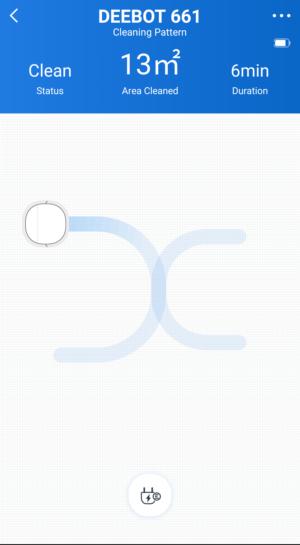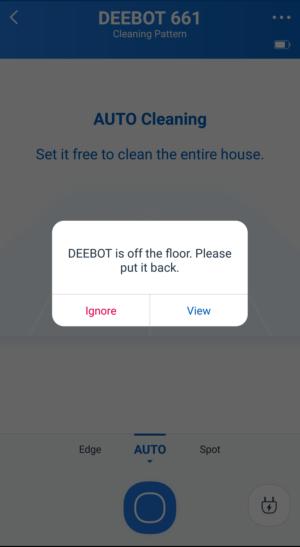Ecovacs has generally impressed with its Deebot line of robot vacuums, but its latest offering—the Deebot 661 Convertible Vacuuming or Mopping Robotic Vacuum Cleaner—doesn’t quite rise to the same level. That said, the Deebot 661 still fills the need for an affordable vacuum/mop hybrid.
The Deebot 661 measures 13.1 inches across by 3.1 inches high, and it weighs about 7 pounds. It continues the design language of other Deebots with a black plastic body and glossy finish. An auto-clean button and Wi-Fi indicator light are on the top of the vacuum, a power switch and reset button are on the side.
On the underside of the 661 are a main roller brush, dual spin brushes, a swivel wheel, and a pair of driving treads. The dustbin is slotted in to the back and can be swapped out for a water tank to mop floors.
 Ecovacs
EcovacsThe Deebot 661’s low height enables it to get under couches and cabinets.
Setting up the 661 follows the same steps I’ve seen with other recent Deebot models. To use it with its physical remote—which provides buttons for automatic cleaning mode selections and manual control—you just set the vacuum on the charging dock, flip its power switch on, and let it charge. It takes about four hours for the battery to reach full capacity, which will give you up to 110 minutes or run time.
To control the vacuum with the Ecovacs Home app, you must take the additional steps of scanning the QR code on the side of the 661, pressing the reset button to pair the 661 with your phone, and following the onscreen prompts to connect to your Wi-Fi network. There are often plenty of hiccups when pairing smart devices with their apps, but the Ecovacs process was typically seamless.
The 661 has three cleaning modes, which can be activated from the remote control, or the app. Auto cleans the entire floor in a random pattern optimized for carpets. Spot mode cleans a small area of concentrated dirt in a spiral pattern. In Edge mode, the vacuum cleans along the walls for the full perimeter of the room. There’s also a Max setting, which doubles the vacuums suction power for tougher messes.
 Michael Ansaldo/IDG
Michael Ansaldo/IDGThe Ecovacs Home app displays real-time information about cleaning jobs.
While the vacuum is cleaning, the app displays real-time data including the size of the area cleaned in square meters, the duration of the cleaning, the battery level, and the current cleaning status, along with a visual representation of the vacuum cleaning.
The app provides pop-up alerts when the 661 runs into trouble. These identify the issue—the vacuum is lifted off the floor, for example—and are accompanied by a gentle beep from the vacuum so you can locate it. You can tap “ignore” to close these notifications, or tap “view” to open a page that explains how to fix the issue. The app keeps a record of all these messages on a separate tab.
You can schedule automatic cleaning in the app. This allows you to choose a cleaning mode, select a start time, and apply it to particular days of the week. The app also tracks all cleaning jobs in a detailed log, along with the usage of the vacuum’s brushes and filters for easy replacement.
You can control the 661 hands free as well. It works with Amazon Alexa and Google Assistant to support simple voice commands.
Mopping
The 661’s somewhat unique mopping system interchanges the dustbin with a 0.3-liter water tank. The tank comes with a mopping cloth velcroed on; all you have to do is pull the rubber plug off, fill the tank from your tap, replace the plug and slot the tank into the back of the vacuum.
The vacuum will automatically convert to mopping mode when the water tank is inserted. It will then cover the entirety of the floor in an up-and-down pattern. It can’t detect the difference between hard floor and carpet though, so if you have areas where one floor type adjoins another, you’ll need to supervise mopping jobs as the 661 doesn’t support any type of virtual boundaries.
Performance
The 661 generally did a good job vacuuming up common household debris like food crumbs, pet hair, and dust. Its modest height also allowed into such low-clearance spots as under cabinets and couches, places where many other robot vacuum’s I’ve tried can’t get to.
 Michael Ansaldo/IDG
Michael Ansaldo/IDGThe app alerts you to problems during cleaning and offers guides to fixing them.
It had a tougher time negotiating different floor surfaces. It had no problem transitioning from carpeting to hardwood and back, but it struggled getting over a throw rug in my entryway, repeatedly setting off an alert that it was off the ground. It also tended to double back over areas it had already cleaned at the expense of areas it hadn’t, which didn’t make for the greatest efficiency.
The mopping function worked about as well as I expected, given that the 661 essentially wipes down the floor with a damp cloth and performs little agitation. It lifted surface dirt with relative ease, but deeper grime was left behind for me to go over with a mop.
Oddly, the 661 only comes with one cloth, so I had to wash and dry it after every cleaning. That wasn’t much of an issue, though, as I have little uncarpeted flooring. It will get tiresome if you have lots of hard flooring that needs regular mopping.
Verdict
The navigation shortcomings I encountered with the Deebot 661 are common to many low-priced, non-mapping robot vacuums, but as I saw recently with the iLife A9, there are robot vacs that have fewer issues than this one. If you can do without the mopping function, you might be better served by one of the many non-hybrid robot vacuums that can be had for around the same price as the 661. If you’re set on a vacuum/mop hybrid model, though, the Deebot 661 is understandably tough to resist as it costs roughly half as much as our current top pick in this category, the Roborock S6. True, you won’t get that model’s support for multiple floor maps and virtual no-go zones, but if you’re living space is uncomplicated and uncluttered, you won’t miss them either.